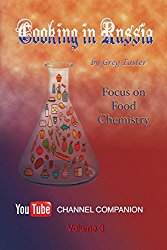
In this third installment the author expounds on the principles of organic chemistry as it relates to food science, interwoven with more than 50 detailed recipes, most of which have accompanying online videos. This unusual book fills a niche that is sorely missing in the literature. Namely, how specific flavors are produced by chemical reactions during cooking and how those reactions can be manipulated to improve results. There are diagrams, tables and explanations covering over 25 different topics. If you have ever wondered about such things as what the exact differences are between types of onions, or what bay leaves actually do at the chemical level, or what makes foods a certain color and what that color indicates, or why fresh tomatoes are sometimes combined with pureed tomatoes in sauces, or the science of how flambeing changes the flavor profile of a dish, or why stocks have to be simmered at a specific temperature for optimum results, and many other such questions, here are the scientifically accurate answers presented in clear language. The text is also sprinkled with tidbits of food history and a humorous take on life in restaurant kitchens. Perhaps even more valuable for chefs and serious cooks, the author introduces a never before seen method for producing your own tertiary flavorings, which are those psychologically tantalizing additives that are the trade secrets of commercial food manufacturers. Only instead of using bottles of chemicals, here this is accomplished using only natural foods, ordinary kitchen equipment and a brilliant novel technique. There is also an extensive glossary of terms relating to beers and wines at the back of the book. If you are an aspiring chef, you absolutely need this book. Understanding food chemistry has never been more important than in this age of molecular gastronomy. This isn't just dry theory. You will be able to make use of these methods in any commercial or home kitchen immediately."